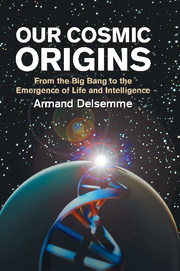Book contents
- Frontmatter
- Contents
- Foreword
- Preface
- Acknowledgments
- 1 Locating humans in the Universe
- 2 The race toward complexity
- 3 The stellar alchemy of metals
- 4 The formation of the planets
- 5 The emergence of life
- 6 The history of life
- 7 The awakening of intelligence
- 8 The other worlds
- 9 Perspectives
- APPENDIX A The standard model of the physics of elementary particles
- APPENDIX B Symmetry in physics
- APPENDIX C The strange role of time in relativity
- APPENDIX D The measurement of long time spans and the age of the Universe
- APPENDIX E The standard model of the Big Bang
- APPENDIX F The cause of the Big Bang and inflation
- APPENDIX G Chirality
- Glossary
- Bibliography
- Figure index
- Table index
- Name index
- Subject index
5 - The emergence of life
Published online by Cambridge University Press: 05 August 2012
- Frontmatter
- Contents
- Foreword
- Preface
- Acknowledgments
- 1 Locating humans in the Universe
- 2 The race toward complexity
- 3 The stellar alchemy of metals
- 4 The formation of the planets
- 5 The emergence of life
- 6 The history of life
- 7 The awakening of intelligence
- 8 The other worlds
- 9 Perspectives
- APPENDIX A The standard model of the physics of elementary particles
- APPENDIX B Symmetry in physics
- APPENDIX C The strange role of time in relativity
- APPENDIX D The measurement of long time spans and the age of the Universe
- APPENDIX E The standard model of the Big Bang
- APPENDIX F The cause of the Big Bang and inflation
- APPENDIX G Chirality
- Glossary
- Bibliography
- Figure index
- Table index
- Name index
- Subject index
Summary
The emergence of life is an expected phase transition from a collection of polymers which do not reproduce themselves, to a slightly more complex collection of polymers, which do jointly catalyze their own reproduction.
Stuart A. Kauffman, The Origins of Order, 1993Evolution toward a growing complexity and organization is the result of fluctuations that lead to a gradual acquisition of autonomy from the environment.
G. Nicolis and I. Prigogine, Self-Organization in Non-equilibrium Systems, 1977The origin of the biosphere
The biosphere is the ensemble of the life-supporting regions of the terrestrial globe. It is made up of the oceans and fresh waters, plus the atmosphere and the layer of soil (spread over the continents) that contains organic matter. Water is the predominant component of the biosphere, in which the atmosphere plays an important role, and where the many compounds of carbon are essential because they are needed by life. In the outer crust of the Earth, however, inorganic carbon is by far the most abundant component, in the form of carbonates (limestone, dolomite, etc.). Heat easily decomposes carbonates and frees carbon in the form of carbon dioxide (CO2); thus this process is the principal source of volcanic CO2.
For a long time, the origin of the biosphere remained a mystery, because no fossil trace exists from the first billion years of the Earth's evolution.
- Type
- Chapter
- Information
- Our Cosmic OriginsFrom the Big Bang to the Emergence of Life and Intelligence, pp. 113 - 154Publisher: Cambridge University PressPrint publication year: 1998

